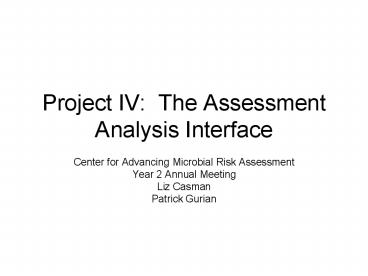Project IV: The Assessment Analysis Interface PowerPoint PPT Presentation
Title: Project IV: The Assessment Analysis Interface
1
Project IV The Assessment Analysis Interface
- Center for Advancing Microbial Risk Assessment
- Year 2 Annual Meeting
- Liz Casman
- Patrick Gurian
2
Risk CommunicationPandemic Flu
- Project IV Year 2
3
Mental Models Interviews
- How do people conceptualize flu transmission and
flu avoidance? - Are their beliefs consistent with current
scientific understanding? Is their knowledge
comprehensive? - What avoidance behaviors do they practice and
why? - Do they act in ways that are contrary to their
conceptualization? When?
4
Expert Model
Draft 2/10/07
5
Risk CommunicationPlanning for Complex Dynamic
Bioterrorism Scenarios
Project IV Year 1
6
- Can I let my children play outdoors?
Influence Diagram
7
What if the bacterium is multiply
antibiotic-resistant?
8
Anthrax Scenario Modeling
Project IV Year 1
9
Anthrax Scenario
- SRA Dec. 2006-slides available
- Simulate fate of anthrax in a building
- can be indoor or outdoor source
- persistent fraction of release will be indoors
(Wein et al.) - Map risk due to air exposure with amount of
anthrax on surfaces
10
Wall samples
Diameter, µM 1 3 5 10
1 in 1000 retrospective risk, B. anthracis /m2 30 80 80 40
2,000-5,000 bugs/office, assumes respirable No
HVAC filter, Druett/Glassman k (Haas 2002)
11
Concentration on HVAC filter
12
Potential future directions
- Swabbing sounds rough.vacuuming maybe better
(water trap per Syed).HVAC concentration effect
worth the PCR interference? - Interpretation of samples and selection of
appropriate sample size is non-trivial - False positives/false negatives
- How large an area to swab?
- How to pronounce site clean enough?
13
Bayesian updating on site risk
- Use a discrete prior for probability of
contamination - Tunable to particular release (results from fate
and transport model if available) - Computationally tractable
- Can be implemented in a spreadsheet
- What do we get?
- Posterior estimate of risk
- Guidance on sample size selection
14
Uncertainty in use of surrogate data
- Project IV Year 2
15
Original Plan Hierarchical Structure
Distribution Ln r N (grand mean, grand variance)
Rabbit r
Human r
Monkey r
16
Dose-response (r)
hot
Strain
humans
rabbits
not so hot
monkeys
rabbits
Less humanlike More humanlike
Host Species
17
Dose-response (r)
hot
Strain
Group 3
Group 1
not so hot
Group 4
Group 2
Less humanlike More humanlike
Host Species
18
Dose-response (r)
hot
Strain
Group 1
Group 3
not so hot
Group 4
Group 2
Less humanlike More humanlike
Host Species
19
Once we have the framework (the map) we can
estimate degree of relatedness from data
prior
posterior
20
Environmental persistence (k)
Microbial characteristic
Fomite character
21
Potential
- When we have data
- May help us organize and interpret large database
of surrogate information - When we dont have data
- May provide a useful structure to capture
experts knowledge of relatedness and
interspecies/strain variability
22
Difficulties
- Requires some priors that do have an intuitive
interpretation, but not a straightforward one - Expert elicitation is fraught with potential
biases - Could be a tendency to group together surrogates
with known similarities on outcome variable - underestimate overall variability
- get surprised
23
Key interfaces for collaboration/exchange
- Experts for strain/species variability
- Data for other hierarchical applications
- Projects I and III
- MDL for surface/HVAC sampling
- Project I
- Water scenario
- Project I
- Input on how to define affected area after a
release - Qualitative algorithms
- Quantitative approaches (Bayesian updating)
- Agencies?
24
- and NSF Grant SES-0433152
25
- Extra slides
26
Anticipate and discourage counterproductive
behaviors
- Burning down derelict buildings or other rodent
harborage - Illegal, counterfeit, alternative, or slow
acting flea control products
- Killing stray animals or sick pets
- Poisoning rodents (vs safe rodent traps)
27
There is a dead squirrel on my lawn. What do I do?
Step Four Using the shovel, place the animal in
the plastic bag.
Step One Do no pick up or touch dead animals.
Step Five Tie a knot in the bag.
Step Two Use a long-handled shovel to pick up
the dead animal.
Step Three Place a strong plastic bag on the
ground.
Step Six Dispose of the bag in an outdoor trash
container.
http//www.co.boulder.co.us/health/environ/vector/
deadAnimal.htm

